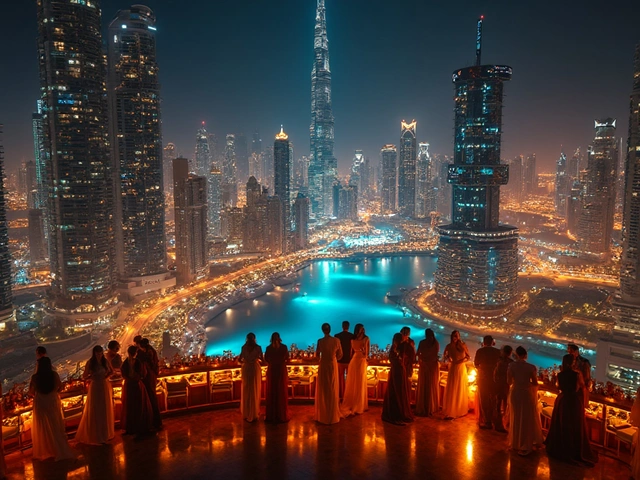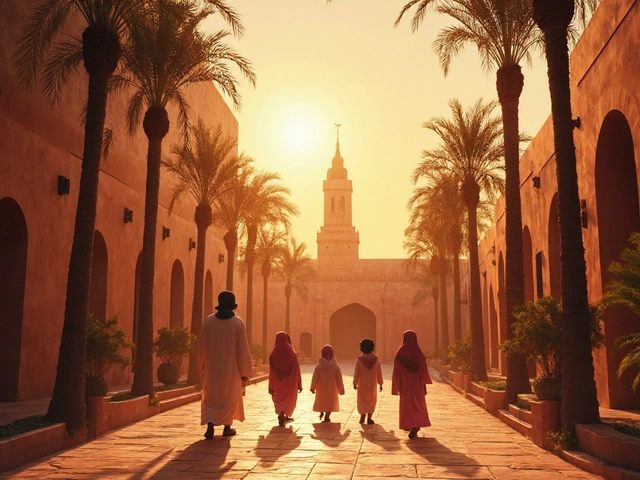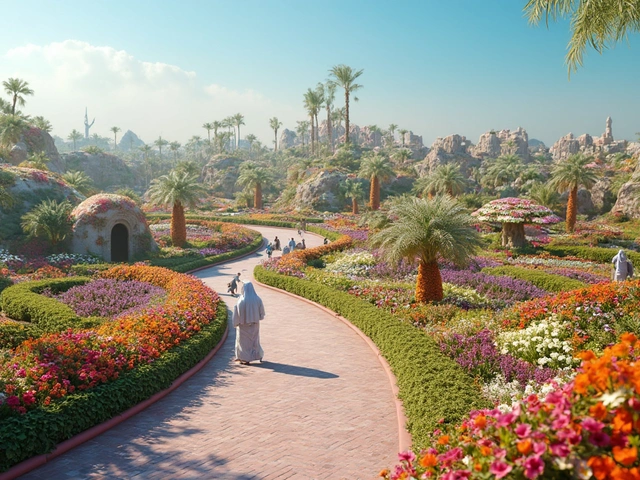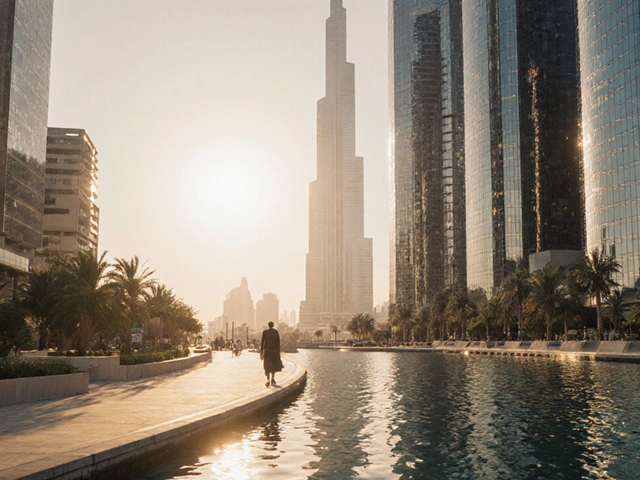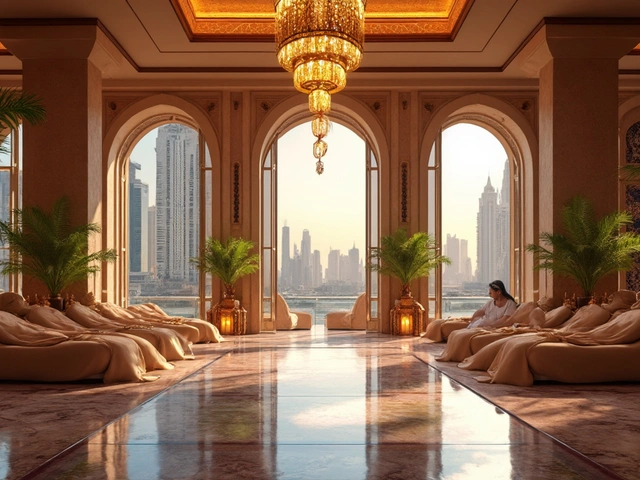Dubai’s landmarks combine flashy innovation with authentic tradition—and it’s surprising how much history hides just a few metro stops from the world’s tallest skyscraper. If you’re living in Dubai or visiting for more than just selfies at the Burj Khalifa, you’ll want to dig a little deeper. From the wind towers in Al Fahidi to the soaring minarets and bustling souks, each spot tells a story that’s way more interesting when you know the background.
Finding the real heart of Dubai means seeing where pearl divers worked, traders bartered, and local families have lived for generations. Public transport like Dubai Metro and water taxis (abra) make it easy to get around the top sights, so you can breeze from the Museum of the Future to Deira’s gold markets without getting stuck in traffic. Most landmarks have prayer areas, and modest clothing is needed in certain venues, especially mosques or heritage houses—bring a light scarf just in case.
Knowing the best times to visit—early morning for the souks, sunset for creekside strolls—means less crowd and better photos. If you want to skip lines and learn fun stories, join a local guided walking tour. Some are even free or especially designed for families, which always helps when you’ve got kids like my chatty Lorelai in tow. Whether you’re planning a weekend adventure or want deeper roots in your city, these landmarks make Dubai’s story come alive.
- Old Dubai: Where Tradition Lives On
- The Rise of Modern Icons
- Dubai’s Places of Worship and Spiritual Heritage
- Fascinating Museums Beyond the Obvious
- Street Life, Bazaars, and Cultural Hotspots
- Tips for Exploring Landmarks Like a Local
Old Dubai: Where Tradition Lives On
Old Dubai isn’t just for tourists who want to snap a photo in front of a wind tower. This area, especially Al Fahidi Historical Neighbourhood, is one of the few places in Dubai where you’ll see how people actually lived before the skyscrapers and malls. The narrow, shady lanes here stay cool even in summer, thanks to the wind towers designed to capture breezes. Local artists and history geeks love the Dubai Museum, which is tucked inside Al Fahidi Fort—the city’s oldest building, dating way back to 1787.
Hop across Dubai Creek on an abra, the same way traders did for centuries. It’s still only 1 dirham per ride and honestly, you can’t beat the view as you cross from Bur Dubai to Deira, where the famous Gold Souk and Spice Souk tempt locals and tourists alike. Pick up saffron, frankincense, or even a cup of fresh juice if you need to keep your cool.
The Sheik Saeed Al Maktoum House gives you a peek into the life of Dubai’s ruling family in the early 20th century. It’s not flashy but it’s packed with old photos, maps, and personal items. If you’ve got kids along, many cultural centers offer workshops—my daughter Lorelai painted her first camel here on a school field trip!
- Start early morning for the Al Fahidi neighbourhood—most places open by 8 or 9 am, and it’s cooler.
- Plan your abra ride around mid-morning to avoid tour groups.
- Bargain at the souks, but don’t expect massive discounts.
- Dress conservatively in these areas out of respect for local customs.
| Landmark | Year Built | Quick Fact |
|---|---|---|
| Al Fahidi Fort | 1787 | The oldest building in Dubai |
| Dubai Creek | Used for trade for 100s of years | Abra rides cost 1 AED |
| Sheikh Saeed Al Maktoum House | 1896 | Home to Dubai's former ruler |
Don’t rush—take time to chat with shopkeepers in the souks or sip Arabic coffee at one of the heritage cafés. This is where you see Dubai’s past come alive, right in the middle of all the modern buzz. If you’re looking for a deep dive into Dubai landmarks, nothing beats Old Dubai for real stories and hands-on experiences.
The Rise of Modern Icons
Dubai’s skyline is famous across the world for a reason. In just a few decades, the city went from simple low-rises to jaw-dropping towers and record breakers that everyone recognizes. If you want to feel the pulse of modern Dubai, it starts with these icons.
At the top of everyone’s list sits the Burj Khalifa. This massive tower isn’t just the tallest building on the planet—rising 828 meters into the clouds—it also offers a killer At the Top observation deck for views you won’t get anywhere else. Book your visit online in advance, or swing by in the late afternoon to watch the sunset and the fountain show below. Bring your camera and some patience for the security line. The Dubai Fountain show happens every evening—standing along the Boardwalk gives you a great view without the crush of crowds in Dubai Mall.
Another landmark you won’t want to skip is the Burj Al Arab, shaped like a sail and often called “the world’s only seven-star hotel.” You can’t just walk in for a look, but booking afternoon tea inside or dinner at one of the restaurants lets you see the over-the-top interiors. Locals know the best free views are from Jumeirah public beach or Umm Suqeim Park—sunset here is Instagram gold.
The Museum of the Future literally looks like something from a sci-fi movie, with its ring-shaped design covered in Arabic calligraphy. Inside, the exhibits are immersive, hands-on, and family-friendly. Buy tickets online weeks ahead, as they sell out fast—there are resident discounts if you live and work in Dubai. Kids go nuts for the “Tomorrow Today” floor, and if you’re short on time, just seeing the building from Sheikh Zayed Road is worth it.
Other spots that have become new city icons include the twisting Cayan Tower in Dubai Marina and the super-green Dubai Frame, which lets you stand between Old Dubai and New Dubai with panoramic city views. The Frame has special entry points for people of determination (that’s local speak for accessibility needs) and is stroller-friendly, so good for families too.
Here’s a quick cheat sheet for tackling these Dubai landmarks:
- Go early or very late for the Burj Khalifa and the Frame to dodge crowds and get the best light for photos.
- Buy tickets online—most icons in the city offer local discounts or family passes.
- For low-cost eating, the Dubai Mall food court has everything, but for more local flavor, try shawarma stands at the Satwa or Jumeirah districts.
- Many of these spots connect by Metro (stop at Burj Khalifa/Dubai Mall or Emirates Towers), so you don’t need to drive or pay for the world’s most creative parking meters.
These modern marvels don’t just stand out for their looks—they actually tell you a ton about Dubai’s skyrocketing ambitions and what’s possible if you dream really, really big.
Dubai’s Places of Worship and Spiritual Heritage
Dubai’s skyline may be packed with towers, but down on the ground, you’ll find a mix of mosques, churches, temples, and even a synagogue, all reflecting the city’s global spirit. It’s a side of Dubai many folks don’t expect, but the diversity and openness will surprise you.
The Dubai landmarks scene isn’t just about shiny buildings—Jumeirah Mosque stands out as the most photographed in the city, and it’s also the only mosque in Dubai that welcomes non-Muslim visitors on guided tours. The tours run several times a week and offer a chance to ask any question about Islamic culture. Don’t forget: modest clothing is a must, but they have scarves and coverings if you need them. The experience is super kid-friendly, with guides sharing simple explanations. You’ll even get dates, Arabic coffee, and a real sense of everyday life tied to worship.
If you’re walking around Bur Dubai, look out for the Grand Mosque, close to the textile souk. The mosque’s 70-meter minaret is hard to miss—it’s the tallest in the city. While the mosque is generally only open to Muslims, its presence shapes the sounds and rhythms of the entire district, especially during Friday prayers and Ramadan.
Dubai’s rich mix extends to Christian groups as well. St. Mary’s Catholic Church in Oud Metha is packed on weekends. There’s also the impressive St. Thomas Orthodox Cathedral and a cluster of other churches nearby, serving people from dozens of countries. Slightly further out, Guru Nanak Darbar Gurdwara in Jebel Ali is one of the region’s largest Sikh temples and stands out for its open-house kitchens and lively gatherings. For anyone interested in interfaith culture, these spaces are welcoming—just call ahead to check open hours or visitor rules.
The recently opened Moses Ben Maimon Synagogue is now part of the Abrahamic Family House in Abu Dhabi, but Dubai’s Jewish community regularly hosts Shabbat dinners and community activities out of private venues, making this city unique in the Gulf for its openness.
- Always check ahead if visitors are allowed at a place of worship, especially outside standard service hours.
- Dress modestly: long trousers and sleeves for adults, and a light scarf for women in mosques and temples.
- Friday, especially midday, is peak prayer time for most mosques—arrive earlier or pick another day for quiet visits.
- Respect photography rules—some sites ask visitors not to take pictures indoors.
| Name | Religion | Open to Visitors? | Location |
|---|---|---|---|
| Jumeirah Mosque | Islam | Yes (Guided Tours) | Jumeirah Beach Road |
| Grand Mosque | Islam | No (Outside Only) | Bur Dubai |
| St. Mary’s Catholic Church | Catholic | Yes | Oud Metha |
| Guru Nanak Darbar Gurdwara | Sikh | Yes | Jebel Ali |
| Moses Ben Maimon Synagogue* | Jewish | Community Activities | Dubai (various/meets privately) |
*For Jewish prayer services, check with the Dubai Jewish Community Centre or online expat forums for current venues and timings.
Exploring these places adds a whole new layer of meaning to Dubai’s story. If you’re showing visitors around or just want to explain a bit of your Dubai life to family back home, a quick stop at these landmarks will spark conversation way beyond travel clichés.
Fascinating Museums Beyond the Obvious
Most folks immediately think of Dubai Museum in Al Fahidi Fort, but there’s a whole lot more hiding in plain sight. If you’re looking to dig deeper into the city’s real character, check out these underrated spots. You won’t find endless crowds, and the hands-on exhibits will make anyone—kids or adults—actually care about history and culture.
- Etihad Museum – This isn’t your standard dusty museum. Sitting on the exact spot where the UAE was founded, it has super modern interactive displays that show off how seven emirates came together in 1971. Locals and expats have said it’s the best place in the city for grasping UAE’s recent past without flipping through boring textbooks.
- Dubai Coffee Museum – Not just for caffeine addicts, this place in Al Fahidi district gives you a taste (literally) of the region’s coffee obsession. There are live demos, old-school brewing tools, and stories about Bedouin hospitality you’ll never hear at Starbucks. Bonus points if you snag a small batch of Emirati-style coffee to take home.
- Museum of Illusions – If you’re bored of traditional exhibitions and want Insta-worthy shots or to blow your kid’s mind, this spot in Al Seef has hands-on mind-benders, 3D puzzles, and even a vortex tunnel. It’s pure fun and actually sneaky educational about perception and science.
- Women’s Museum Bait Al Banat – Tucked in Deira near the gold souk, it shines a spotlight on influential Emirati women—artists, poets, business leaders—from the past to today. Quiet, uncrowded, and super inspiring if you want your daughters to see local role models.
- Saruq Al Hadid Museum – Right in the heritage area, this one’s a treat for history geeks. It’s all about a UAE Iron Age archaeological site. There are real artifacts, ancient jewelry, and interactive bits for kids. It’s way different from Dubai’s futuristic vibe.
Here’s a quick look at some useful info that’ll make your museum hopping easier:
| Museum Name | Location | Opening Hours | Admission Fee | Family-Friendly? |
|---|---|---|---|---|
| Etihad Museum | Jumeirah 1 | 10am-8pm (last entry 7pm) | AED 25/adult; AED 10/child | Yes |
| Dubai Coffee Museum | Al Fahidi Historical Neighbourhood | 9am-5pm, Sat-Thu | Free | Yes |
| Museum of Illusions | Al Seef | 10am-10pm | AED 80/adult; AED 60/child | Absolutely |
| Women’s Museum Bait Al Banat | Deira | 10am-7pm (Sat-Thu) | AED 20 | Yes |
| Saruq Al Hadid Museum | Shindagha Heritage District | 8am-8pm (Sat-Thu) | AED 20/adult; AED 10/child | Yes |
Tip: Keep an eye out for annual cultural events like Dubai Museum Week—some museums offer free entry or guided tours during these times. Also, many spots have gift shops with local crafts, not just postcards and mugs. For UAE residents, using your Emirates ID sometimes gets you a discount or free access, so don’t forget it at home.
Street Life, Bazaars, and Cultural Hotspots
You can’t talk about Dubai landmarks and leave out its legendary street markets and lively corners where culture comes to life. Even with all the futuristic towers, real Dubai magic is in places like the Deira Gold Souk, where you’ll see over 300 shops with every style of gold you can imagine. If you’re hunting spices, cross over to the Spice Souk for vanilla, saffron, or just the scent of old Dubai wafting through narrow lanes. The haggling here isn’t just tolerated—it’s part of the experience.
Another place not to miss: Al Seef on Dubai Creek. It’s a restored waterfront area that blends the old and the new. You’ll find contemporary cafes steps from classic dhow boats and shops selling Emirati crafts. The vibe is relaxed and family-friendly, which is perfect if you’ve got kids (mine loves spotting the lanterns at sunset). If you’re more of a night owl, the Global Village is a seasonal must in cooler months—think food, performances, and pop-ups from almost 80 countries every evening.
"Souks are the best places to see how Dubai keeps its heritage alive," says Mohamed Al Blooshi, heritage guide at Sheikh Mohammed Centre for Cultural Understanding. "Here, you’ll find stories you won’t get in any museum."
For the artsy crowd, Alserkal Avenue in Al Quoz is the heartbeat of contemporary culture—galleries, indie cinemas, quirky events, and a great local coffee scene. Even if you’re not into art, check the calendar; there’s almost always something random and cool, from street food pop-ups to film screenings in the warehouses.
Here’s a quick look at some key spots and hours so you can plan smart:
| Spot | Main Attraction | Recommended Visit Hours | Entry |
|---|---|---|---|
| Deira Gold Souk | Gold & Jewelry | 10 AM - 10 PM | Free |
| Spice Souk | Spices & Herbs | 10 AM - 10 PM | Free |
| Alserkal Avenue | Art Galleries | 10 AM - 7 PM | Free |
| Global Village | Food, Culture, Shopping | 4 PM - Midnight (Oct-Apr) | AED 25 |
| Al Seef | Creekside Dining & Heritage | All Day | Free |
Tip: Fridays in the souks get busy after 5 PM, so if you prefer less crowd, hit the markets on weekday mornings. Cash is handy for deals on smaller items—even though many stalls take cards now, the best bargains might still favor old-school dirhams. Try the local snacks: luqaimat (sweet dumplings) in Al Seef or karak chai (strong tea) from any tiny roadside café. You’ll remember the taste just as much as the experience.
Tips for Exploring Landmarks Like a Local
If you want Dubai landmarks to really wow you, skip the usual tourist shuffle and go in with a local’s mindset. Here’s what works for families, expats, and lifelong residents who want more than just crowded photos at busy hours.
- Dubai landmarks are best visited early in the morning or late in the afternoon—less heat, fewer crowds. For example, Dubai Creek is almost empty by 8am, and the light at sunset along Al Seef is gorgeous for photos.
- Buy tickets online where you can. The Burj Khalifa’s At The Top lets you reserve a slot in advance, which can save you at least 45 minutes (no one likes wasting time in a line when everything else is waiting).
- Use the Dubai Metro for all the main sights. Stations are air-conditioned and often just a ten-minute walk from major attractions—Gold Souk, Al Fahidi, Dubai Frame. If you’re heading to Old Dubai, RTA’s traditional abra ride (just AED 1!) is quick, fun, and truly local.
- Dress for the day. If you’re heading into mosques—like Jumeirah Mosque—or old neighborhoods, go for loose, light clothing. Pack a scarf for women and big hats for kids. Many venues offer shawls, but it’s easier to have your own.
- Snack smart. Grab fresh juice or a shawarma from street vendors in Deira or Karama for under AED 10. Al Mallah and Al Ustad Special Kabab are crowd favorites, and you’ll always see Emiratis and longtime residents in the mix.
- Try a guided walking tour, especially in Al Fahidi or Deira. These often cost less than AED 100, sometimes as little as AED 50, and you’ll hear stories and quirks Google will never tell you. Heritage Express and Frying Pan Adventures are big names.
For more stats on peak and low visitation hours, here's what you can expect on a typical week:
| Landmark | Peak Hours | Quietest Slots |
|---|---|---|
| Burj Khalifa | 4pm - 7pm | 8am - 10am |
| Dubai Museum | 3pm - 6pm | 10am - 12pm |
| Al Fahidi District | Weekends 1pm - 4pm | Weekdays 9am - 11am |
| Gold Souk | Evenings, esp. Fri-Sat | 10am - 12pm |
If you’ve got kids, landmarks like the Dubai Frame or Museum of Illusions are perfect in the early afternoon, right after school lets out—but before the tourist rush. Many spots have family restrooms and kids’ play areas, and the bigger malls (like Dubai Mall, right next to the Burj Khalifa) offer stroller rentals.
Finally, don’t forget to join Dubai’s festivals—like the Dubai Shopping Festival or Al Marmoom Heritage Festival—if you’re around. Landmarks transform during these times: decorations, street performances, and food trucks pop up everywhere, giving you a different view and flavor of the city. That’s the true local experience.

